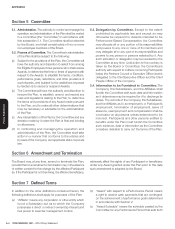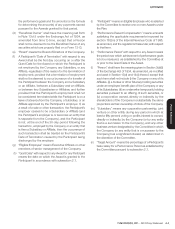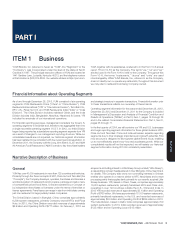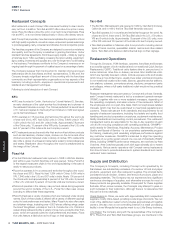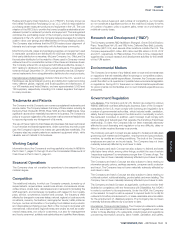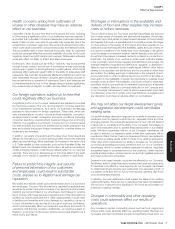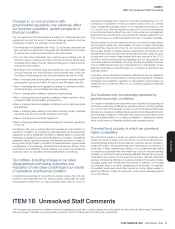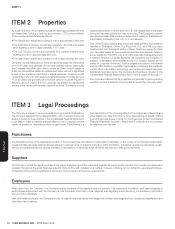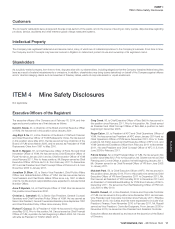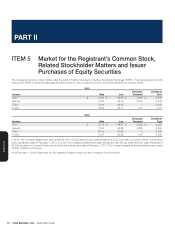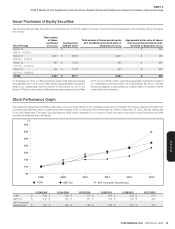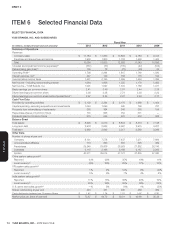Pizza Hut 2013 Annual Report Download - page 100
Download and view the complete annual report
Please find page 100 of the 2013 Pizza Hut annual report below. You can navigate through the pages in the report by either clicking on the pages listed below, or by using the keyword search tool below to find specific information within the annual report.
YUM! BRANDS, INC.-2013 Form10-K4
Form 10-K
PART I
ITEM 1Business
Restaurant Concepts
Most restaurants in each Concept offer consumers the ability to dine in and/or
carry out food. In addition, Taco Bell and KFC offer a drive-thru option in many
stores. Pizza Hut offers a drive-thru option on a much more limited basis. Pizza
Hut and KFC, on a more limited basis primarily in China, offer delivery service.
Each Concept has proprietary menu items and emphasizes the preparation of food
with high quality ingredients, as well as unique recipes and special seasonings
to provide appealing, tasty, convenient and attractive food at competitive prices.
The franchise programs of the Company are designed to promote consistency
and quality, and the Company is selective in granting franchises. Under
standard franchise agreements, franchisees supply capital – initially by paying
a franchise fee to YUM, purchasing or leasing the land, building, equipment,
signs, seating, inventories and supplies and, over the longer term, by reinvesting
in the business. Franchisees contribute to the Company’s revenues on an
ongoing basis through the payment of royalties based on a percentage of sales.
The Company believes that it is important to maintain strong and open
relationships with its franchisees and their representatives. To this end, the
Company invests a significant amount of time working with the franchisee
community and their representative organizations on key aspects of the
business, including products, equipment, operational improvements and
standards and management techniques.
Following is a brief description of each Concept:
KFC
•
KFC was founded in Corbin, Kentucky by Colonel Harland D. Sanders,
an early developer of the quick service food business and a pioneer of
the restaurant franchise concept. The Colonel perfected his secret blend
of 11 herbs and spices for Kentucky Fried Chicken in 1939 and signed
up his first franchisee in 1952.
•
KFC operates in 118 countries and territories throughout the world. As
of year end 2013, KFC had 4,563 units in China, 9,460 units in YRI,
4,491units in the U.S. and 361 units in India. Approximately 78 percent
of the China units, 11 percent of the YRI units, 5 percent of the U.S. units
and 47 percent of the India units are Company-owned.
•
KFC restaurants across the world offer fried and non-fried chicken products
such as sandwiches, chicken strips, chicken-on-the-bone and other
chicken products marketed under a variety of names. KFC restaurants
also offer a variety of entrees and side items suited to local preferences
and tastes. Restaurant decor throughout the world is characterized by
the image of the Colonel.
Pizza Hut
•The first Pizza Hut restaurant was opened in 1958 in Wichita, Kansas,
and within a year, the first franchise unit was opened. Today, Pizza Hut
is the largest restaurant chain in the world specializing in the sale of
ready-to-eat pizza products.
•
Pizza Hut operates in 91 countries and territories throughout the world.
As of year end 2013, Pizza Hut had 1,264 units in China, 5,490 units in
YRI, 7,846 units in the U.S. and 367 units in India. Nearly 100 percent of
the China units and approximately 4 percent of the YRI units, 6 percent
of the U.S. units and 5 percent of the India units are Company-owned.
•
Pizza Hut operates in the delivery, carryout and casual dining segments
around the world. Outside of the U.S., Pizza Hut often uses unique
branding to differentiate these segments.
•
Pizza Hut features a variety of pizzas which are marketed under varying
names. Each of these pizzas is offered with a variety of different toppings
suited to local preferences and tastes. Many Pizza Huts also offer pasta
and chicken wings, including over 4,800 stores offering wings under
the brand WingStreet, primarily in the U.S. Outside the U.S., Pizza Hut
casual dining restaurants offer a variety of core menu products other than
pizza, which are typically suited to local preferences and tastes. Pizza
Hut units feature a distinctive red roof logo on their signage.
Taco Bell
•
The first Taco Bell restaurant was opened in 1962 by Glen Bell in Downey,
California, and in 1964, the first Taco Bell franchise was sold.
•
Taco Bell operates in 21 countries and territories throughout the world. As
of year end 2013, there were 5,769 Taco Bell units in the U.S., 279 units in
YRI and 5 units in India. Approximately 15 percent of the U.S. units, none
of the YRI units and 100 percent of the India units are Company-owned.
•Taco Bell specializes in Mexican-style food products, including various
types of tacos, burritos, quesadillas, salads, nachos and other related
items. Taco Bell units feature a distinctive bell logo on their signage.
Restaurant Operations
Through its Concepts, YUM develops, operates, franchises and licenses
a worldwide system of both traditional and non-traditional Quick Service
Restaurants (“QSR”). Traditional units feature dine-in, carryout and, in
some instances, drive-thru or delivery services. Non-traditional units,
which are typically licensed outlets, include express units and kiosks
which have a more limited menu, usually lower sales volumes and operate
in non-traditional locations like malls, airports, gasoline service stations,
train stations, subways, convenience stores, stadiums, amusement parks
and colleges, where a full-scale traditional outlet would not be practical
or efficient.
Restaurant management structure varies by Concept and unit size. Generally,
each Concept-owned restaurant is led by a restaurant general manager
(“RGM”), together with one or more assistant managers, depending on
the operating complexity and sales volume of the restaurant. Most of
the employees work on a part-time basis. Each Concept issues detailed
manuals, which may then be customized to meet local regulations and
customs. These manuals set forth standards and requirements for all
aspects of restaurant operations, including food safety and quality, food
handling and product preparation procedures, equipment maintenance,
facility standards and accounting control procedures. The restaurant
management teams are responsible for the day-to-day operation of each
unit and for ensuring compliance with operating standards. CHAMPS –
which stands for Cleanliness, Hospitality, Accuracy, Maintenance, Product
Quality and Speed of Service – is our proprietary systemwide program
for training, measuring and rewarding employee performance against
key customer measures. CHAMPS is intended to align the operating
processes of our entire system around one core set of standards. RGMs’
efforts, including CHAMPS performance measures, are monitored by Area
Coaches. Area Coaches typically work with approximately six to twelve
restaurants. Various senior operators visit Concept-owned restaurants
from time to time to promote adherence to system standards and mentor
restaurant team members.
Supply and Distribution
The Company’s Concepts, including Concept units operated by its
franchisees, are substantial purchasers of a number of food and paper
products, equipment and other restaurant supplies. The principal items
purchased include chicken, cheese, beef and pork products, paper and
packaging materials. The Company has not experienced any significant
continuous shortages of supplies, and alternative sources for most of
these products are generally available. Prices paid for these supplies
fluctuate. When prices increase, the Concepts may attempt to pass on
such increases to their customers, although there is no assurance that
this can be done practically.
China Division In China, we work with approximately 650 independent
suppliers, mostly China-based, providing a wide range of products. We own
most of the distribution system which includes approximately 20 logistics
centers. We also own a non-controlling interest in a meat processing
facility in Inner Mongolia that supplies meat to our Little Sheep business.
U.S. Division The Company, along with the representatives of the Company’s
KFC, Pizza Hut and Taco Bell franchisee groups, are members in the




